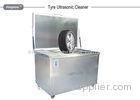

Car Tyre / Wheel Custom Ultrasonic Cleaner with Rotation System
| Place of Origin: | Zhejiang |
|---|
Company Profile
| Location: | Shenzhen, Guangdong, China (Mainland) |
|---|---|
| Business Type: | Manufacturer |
Product Detail
| Model No.: | LS-9001 |
|---|
Product Description
Limplus Car Tyre / Wheel Custom Ultrasonic Cleaner with Rotation System
Why choose ultrasonic cleaner as car tyre / wheel clean?
1. reduce maintenance down time
2. eliminate hand-cleaning
3. replace troublesome solvents and harsh abrasives that may damage the tyre surface
4. improve cleaning effectiveness as chemistry and ultrasonics gently clean even intricate designs and patterns
5. decrease labor expenses
Feature:
1. save labor cost and time: about 10minutes cleaning time
2. with digital control panel
3. with Motor rotation system: Tyre can be rotate in tank while cleaning.
4. with pneumatic lift: automatically up and down the tyre before and after cleaning.
5. Equipped with professional industrial ultrasonic transducers.
6. Separate generator control
7. Engineers with more than 10 years experiences in ultrasonic field.
8. 12months warranty.
Specifications:
| Model No. | LS-9001 |
| Tank Dimension(mm) | 900x560x900mm |
| Capacity | 453liter |
| Case material | SUS 304 |
| Tank material | SUS304/316L |
| Ultrasonic power | 4500W |
| Heating power | 12KW |
| ultrasonic frequency | 28kHz |
| Temperature | 20~80C adjust |
| Suitable tyre size | Width: 135~350mm, Diameter: 500~800mm |
| Timer | 1~99hour adjust |
| Voltage of tank | AC220V / AC380 / AC415V, 3phase |
| Voltage of generator | AC110V / AC220V, 1phase |
| Accessories | pneumatic lifting system, rotation system |
When temperature is needed?
Temperature plays a crucial role in the cleaning process. The number of cavitation bubbles increases proportionally to temperature increase. This happens up to about 60°C beyond which cavitation begins to decline and stops completely when the liquid’s boiling point is reached. However as the temperature and vapor pressure increase the cavitation energy decreases. Thus, each cleaning chemistry provides maximum cleaning efficacy at an optimum temperature setting.
How to choose suitable frequency?
High frequency is for fine particles and cleaning of very small features on substrates;
Lower frequency is suitable for heavy and coarse contaminants.
What cleaning solution should I use?
A large variety of different formulas designed for specific applications. Proper selection is crucial for acceptable cleaning activity and to prevent unwanted reactions with the workpiece.

